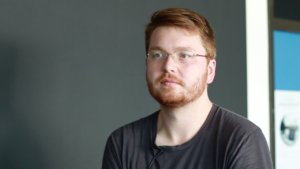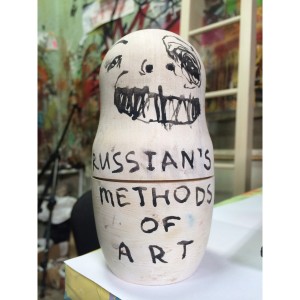We work a lot with texts, or like reading is the core of performance. But there is a lot of like movement, research involved, like staging this performance. But we work with installation, with a variety of materials, I guess, whatever like we feel that can like illustrate or kind of- maybe not illustrate, but kind of create a situation for this text, so it’ll create this intimate kind of environment, suggestive of a text or like the ideas that we kind of translated from the text. (D.G.): Yeah, we also want to make environments that are somehow like moldable and modifiable, I think. So, we kind of bring together different elements that can interact somehow and be interacted with. So, I guess, that’s kind of really important with each work. (E.K.): Mhm, and I guess image making and documentation is very important to us, too. Like staging this documentation for the camera but also in the variety of different ways. Like, we produced a fragrance also as like a documentation of a performance. (D.G.): Yes, so it’s kind of like thinking about the, like this imprint of- or whatever is left after this kind of sensual experiencing of a performance. And I guess, it’s really like – the fragrance is a really good example because there we kind of tried to think of a choreography that would make the performance smell in a certain way. So we divided the- divided the piece into six different acts and each act was somehow a creation of a certain smell that was later captured. So, it’s somehow like this final outcome which is a fragrance- like a fine fragrance in a traditional sense, something that could be worn on the body that smells attractive. That was like in a way a starting point for the performance in the movement and- yeah, the choreography, the objects, the props, that were used. So, it’s somehow thinking about these molecules that like contribute to the space, before you kind of make the space nearly. And similarly, we worked similarly often with images also, we think about the image, when we kind of make the work, too. (E.K.): And I guess, like another material, I guess, you can call this collaboration, like people that you work with and then these Ideas, like the new Ideas that come in. Because this fragrance, we developed like with a perfume company, international flavors and fragrances, I guess they make not only fragrance but flavors also, but like they have all the skills, scientific skills, to produce like new fragrance material. So they helped us in this technical way to capture the smell of the space and then synthetically reproduced it. In their lab, which was very interesting and maybe like not possible for us on our own to make it, you know. Like the variety of skills, I guess (D.G.): I guess, for this particular performance, we were interested in imprints of environments on the body. So, that’s why we chose like white as a color for the costume. I guess, just to show that the traces are visible somehow on the costume. The traces of this clay installation. And the first editions had a costume made by us, but now we are thinking that like it’s nice to kind of like collaborate with someone and to get new ideas into this costume making. Like in kind of in conversation with them. The costume is … yes so it’s always made in relation to what the setting is. So, the pieces are also made from terrycloth, so they somehow pick up a lot of this environment, they move it elsewhere with the movements of the bodies, of the performers, they leave stains on the walls around this space and similarly the- kind of the basic setting really takes all the imprints. So, it’s just somehow about like this mutual change of the environment and the performers.

















